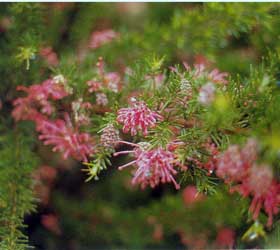Grevilleas

Grevillea
Spider Flower
Family Proteaceae
Approximately. 270 species, plus a rapidly increasing range of named hybrids and cultivars.
Many are ideal for small gardens; most being small to medium shrubs. Many are very ornamental.
They are good bee and bird attractors. Most look good amongst other shrubs particularly if selected to provide contrast in foliage texture or colour.
Some grow well as tub plants; and others are good for screening and hedging.
The appearance is extremely variable, though all are evergreen. Fine leaved cultivars give an open textured appearance that can be used to make small garden seem a little larger. Large leaved cultivars can make a small garden seem even smaller.
Flowers are colourful, obvious and contain long thin pieces (stigmas) that give a spider like appearance. Most flower for long periods off and on all year round.
There are Grevilleas to suit most conditions, except for poorly drained sites. Most prefer Mediterranean climates, some do well in tropical rainforests, others do well in deserts, and yet others in cold alpine areas. They often occur in well drained, low fertility soils. Hardiness varies but most are hardy. Generally adapt to most soils, some prefer acid, many prefer clay; all require good drainage. Many varieties are difficult to grow in salt affected soils.
Most shrub types do best in part or lightly filtered sunlight. Some will succeed in full sun or shade.
Most shrubby types can be kept bushy by regular tip pruning. Avoid fertilisers containing Phosphorus, as most members of the Proteaceae plant family, Grevilleas included, are adapted to soils with low phosphorus levels. High Phosphorus can cause plant death.
Lightly tip prune several times each year. If the plant becomes seriously overgrown, a severe pruning in most cases will rejuvenate the plant.
Propagate most by semi-hardwood cuttings, some by seed (e.g. G. robusta), or grafting.
Grevilleas readily hybridise so unless you are interested in breeding new varieties, cutting propagation is generally the best option.
Pests are not common but can on some types include borers, scale, bugs, caterpillars and leaf miners. Diseases can include leaf spots, root rots, sooty mould, Phytopthera cinnamomi (Cinnamon Fungus) and fasciation (distorted growths).
Most Grevilleas can cause a skin allergy if brushed against.
Cultivars
There are species which suit gardens in virtually any part of Australia; but it is important to choose the appropriate species for your locality. Many of the hybrids now available, are being grown increasingly more than the species.
HYBRIDS
GREVILLEA CLEARVIEW HYBRIDS
Hybrids from the nursery of Mr W. Cane of Maffra in Victoria
G. ‘Clearview David’ -to 40cm tall, spreading, rich red flowers, prickly green needle like foliage.
G. ‘Clearview Dwarf’ -to 30cm tall and 1m diameter, red flowers.
G. ‘Clearview Robin’ -upright bush to 2.5m tall, greyish leaves, red & cream flowers.
GREVILLEA BANKSII
Grevillea banksii hybrids ‑ The first and most popular of these was Grevillea `Robyn Gordon'. This was grown at D.M. Morgan's property at Glenmorgan in Qld from G .banksii and G. pinnatifida. Many other similar hybrids (such as ‘Ned Kelly’, ‘Misty Pink’, ‘Honey Gem’, etc) have been produced since then. The major attraction is their large spectacular flowering heads. These hybrids grow well in either temperate or sub tropical to tropical climates.
G. ‘Honey Gem’ -4 to 5m tall, to 2m spread, divided leaves, Rich orange flowers most of the year.
G. ‘Ned Kelly’ -to around 2m tall and 2.5m spread, orange red flowers.
G. ‘Robyn Gordon’ -to 2.5m tall and 2.5m spread, red flowers, can be more susceptible to scale and sooty mould than other cultivars.
GREVILLEA ALPINA
Grevillea alpina ‑ many different varieties occur in the wild, varying in height from 1.5 metres down to prostrate plants; flower colour varying from creams and whites, through yellows, apricots, reds etc. The varieties are normally given the name of the region they come from.
Grevillea alpina `Beechworth' is an orange/red and yellow flower from Beechworth in Victoria.
GREVILLEA ROSMARINIFOLIA
Grevillea rosmarinifolia – usually with red flowers, to around 2m and slightly prickly green foliage, many varieties occur naturally, others have been produced by both intentional and unintentional breeding. Examples include: G.rosmarinifolia `Pink Pearl' (2m X 2m), G. ‘Clearview David’ (3m X 3m), G. ‘Rosie Posy’ (1.2 X 1.2m), and G. rosmarinifolia green form (1.2 X 1.2m with green-yellow flowers), etc
POORINDA HYBRIDS
Grevillea Poorinda hybrids ‑ At Poorinda near Buchan in Victoria, a great number of hybrids occurred naturally in the garden of Mr Leo Hodge, resulting from local species crossing with introduced species.
Examples include:
G.’Poorinda Constance’ -2 to 3m tall, to 2.5m spread, scarlet flowers all year.
G.’Poorinda Elegance’ -to 2.5m tall and 2.5m spread, scarlet flowers all year, glossy foliage.
G.’Poorinda Queen’ -around 2m tall and 2m spread, green leaves, orange flowers in spring and summer.
G.’Poorinda Firebird’ -1 to 2m tall and 1 to 2m spread, bright red flowers late winter and spring, grey green foliage.
You may also be interested in....